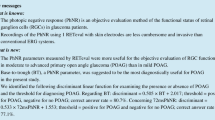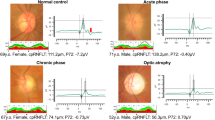Abstract
Purpose
The electroretinogram (ERG) has proven to be useful in the evaluation and monitoring of patients with posterior uveitis. ERG oscillatory potentials (OPs) are sometimes reduced in many uveitic eyes with otherwise grossly normal ERG responses. This study compares ERG parameters, including OPs, between patients with birdshot chorioretinopathy, other posterior uveitis, and controls.
Methods
This was a retrospective case–control study. Sixty-four patients seen at a clinical practice had a total of 93 visits during which ERG was performed on both eyes. ERG data from 93 age-matched controls were also collected. Root-mean-squared (RMS) energy of the OPs was calculated using Fourier analysis for 88 patients and 88 age-matched controls for whom complete data were available. Photopic flicker amplitudes, photopic flicker latencies, scotopic b-wave amplitudes, and OP RMS values were compared between patients and controls. Diagnostic performance was assessed using receiver operating characteristic (ROC) curves.
Results
The mean ages of patients and controls were 55.9 ± 10.8 (SD) years and 55.1 ± 11.5, respectively. 83% of the patients had a diagnosis of BCR. The mean OP RMS value was significantly different in patients (15.6 µV ± 9.7 µV) versus control eyes (33.0 µV ± 12.7 µV), p < 0.001. Area under the ROC curves (AUROC) was 0.75 for photopic flicker amplitudes, 0.77 for photopic flicker latencies, 0.72 for scotopic b-wave amplitudes, and 0.88 for OP RMS. AUROC was significantly different between OP RMS and photopic flicker amplitudes (p < 0.001), between OP RMS and flicker latencies (p = 0.0032), and between OP RMS and scotopic b-wave amplitudes (p < 0.0001).
Conclusion
Analysis of OPs shows greater sensitivity and specificity in the diagnosis and evaluation of patients with birdshot chorioretinopathy than photopic and scotopic ERG amplitudes and photopic flicker latencies.









Similar content being viewed by others
References
Brown TK (1968) The electroretinogram: its components and their origins. Vis Res 8:633–677
Moschos MM, Gouliopoulos NS, Kalogeropoulos C (2014) Electrophysiological examination in uveitis: a review of the literature. Clin Ophthalmol 8:199–214
Perlman I (1983) Relationship between the amplitudes of the b wave and the a wave as a useful index for evaluating the electroretinogram. Br J Ophthalmol 67(7):443–448
Sobrin L, Lam BL, Liu M, Feuer WJ, Davis JL (2005) Electroretinographic monitoring in birdshot chorioretinopathy. Am J Ophthalmol 140(1):52.e18–52.e51
Ryan SJ, Maumenee AE (1980) Birdshot retinochoroidopathy. Am J Ophthalmol 89(1):31–45
Oh KT, Christmas NJ, Folk JC (2002) Birdshot retinochoroiditis: long term follow-up of a chronically progressive disease. Am J Ophthalmol 133(5):622–629
Wakefield D, Chang JH (2005) Epidemiology of uveitis. Int Ophthalmol Clin 45(2):1–13
Rothova A, Berendschot TTJM, Probst K, van Kooij B, Baarsma GS (2004) Birdshot chorioretinopathy: long-term manifestations and visual prognosis. Ophthalmology 111(5):954–959
Zacks DN, Samson MC, Loewenstein J, Foster SC (2002) Electroretinograms as an indicator of disease activity in birdshot retinochoroidopathy. Graefe’s Arch Clin Exp Ophthalmol 240(8):601–607
Priem HA, De Rouck A, De Laey J-J, Bird AC (1988) Electrophysiologic studies in birdshot chorioretinopathy. Am J Ophthalmol 106(4):430–436
Hirose T, Katsumi O, Pruett RC, Sakaue H, Mehta M (1991) Retinal function in birdshot retinochoroidopathy. Acta Ophthalmol 69(3):327–337
Tzekov R, Madow B (2015) Visual electrodiagnostic testing in birdshot chorioretinopathy. J Ophthalmol 2015, Article ID 680215
Speros P, Price J (1981) Oscillatory potentials. History, techniques and potential use in the evaluation of disturbances of retinal circulation. Surv Ophthalmol 25(4):237–252
Wachtmeister L (1998) Oscillatory potentials in the retina: what do they reveal. Prog Retinal Eye Res 17(4):485–521
Algvere P, Westbeck S (1972) Human ERG in response to double flashes of light during the course of dark adaptation: a fourier analysis of the oscillatory potentials. Vis Res 12(2):195–214
McCulloch DL, Marmor MF, Brigell MG et al (2015) ISCEV Standard for full-field clinical electroretinography (2015 update). Doc Ophthalmol 130(1):1–12
Gauthier M, Gauvin M, Lina J-M, Lachapelle P (2019) The effects of bandpass filtering on the oscillatory potentials of the electroretinogram. Doc Ophthalmol 138:247–254
McClish DK (1989) Analyzing a portion of the ROC curve. Med Decis Making 9:190–195
Gauvin M, Lina J-M, Lachapelle P (2014) Advance in ERG analysis: from peak time and amplitude to frequency, power, and energy. Biomed Res Int 2014:246096
Funding
This study was supported in part by an unrestricted Grant to the NYU Langone Department of Ophthalmology from Research to Prevent Blindness.
Author information
Authors and Affiliations
Corresponding author
Ethics declarations
Ethical approval
All procedures performed in studies involving human participants were in accordance with the ethical standards of the Medical Ethical Research Committee of the University Medical Centre Utrecht and with the 1964 Helsinki Declaration and its later amendments or comparable ethical standards.
Informed consent
This was a retrospective chart review. Informed consent was not obtained from study subjects, as approved by the NYU Langone IRB.
Statement of human rights
All procedures performed in studies involving human participants were in accordance with the ethical standards of the NYU Langone Institutional Review Board (Study Number 18-01348_CR2) and with the 1964 Helsinki Declaration and its later amendments or comparable ethical standards.
Statement on the welfare of animals
No animals were used in this study.
Additional information
Publisher's Note
Springer Nature remains neutral with regard to jurisdictional claims in published maps and institutional affiliations.
Rights and permissions
About this article
Cite this article
Wang, D., Nair, A., Goldberg, N. et al. Oscillatory potentials in patients with birdshot chorioretinopathy. Doc Ophthalmol 141, 293–305 (2020). https://doi.org/10.1007/s10633-020-09776-x
Received:
Accepted:
Published:
Issue Date:
DOI: https://doi.org/10.1007/s10633-020-09776-x




